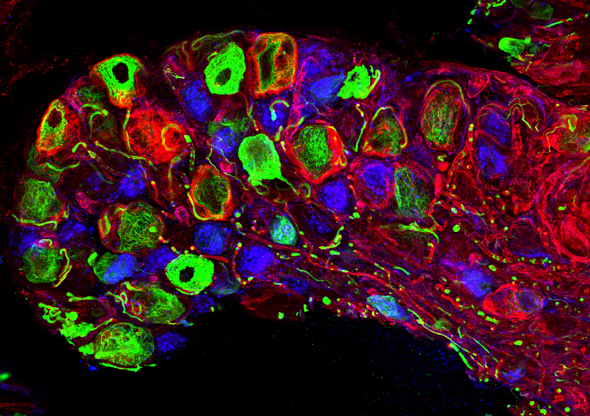Nerves as never before

Image credit: EMBL/L.Castaldi
The riot of colour before your eyes provides a glimpse at another sense: touch.
When something brushes a mouse’s skin, or the temperature around it changes, this bundle of nerves relays that information from touch receptors on the skin to the spinal cord and ultimately the brain, where it can be processed and acted upon.
Neurons involved in sensing light touch are shown in green, and two different types of nerve cell involved in sensing pain are labelled red and blue.
The image was obtained through a novel technique developed by Paul Heppenstall’s lab at the European Molecular Biology Laboratory (EMBL) in Monterotondo, Italy, which enables researchers to explore tissues in mice in much greater detail than ever before.
Published online in Nature Methods on 8 December 2014. DOI: 10.1038/nmeth.3207.
Additional images and extended captions: www.embl.org/press/2014/141208_Monterotondo_picr .
For more information please visit: www.embl.org/press/2014/141208_Monterotondo .
***High resolution images available upon request.***
——————————
Policy regarding use
EMBL press and picture releases including photographs, graphics and videos are copyrighted by EMBL. They may be freely reprinted and distributed for non-commercial use via print, broadcast and electronic media, provided that proper attribution to authors, photographers and designers is made.
——————————
Sonia Furtado Neves
EMBL Press Officer & Deputy Head of Communications
Meyerhofstr. 1, 69117 Heidelberg, Germany
Tel.: +49 (0)6221 387 8263
Fax: +49 (0)6221 387 8525
sonia.furtado@embl.de
http://s.embl.org/press
Media Contact
All latest news from the category: Life Sciences and Chemistry
Articles and reports from the Life Sciences and chemistry area deal with applied and basic research into modern biology, chemistry and human medicine.
Valuable information can be found on a range of life sciences fields including bacteriology, biochemistry, bionics, bioinformatics, biophysics, biotechnology, genetics, geobotany, human biology, marine biology, microbiology, molecular biology, cellular biology, zoology, bioinorganic chemistry, microchemistry and environmental chemistry.
Newest articles

A universal framework for spatial biology
SpatialData is a freely accessible tool to unify and integrate data from different omics technologies accounting for spatial information, which can provide holistic insights into health and disease. Biological processes…

How complex biological processes arise
A $20 million grant from the U.S. National Science Foundation (NSF) will support the establishment and operation of the National Synthesis Center for Emergence in the Molecular and Cellular Sciences (NCEMS) at…

Airborne single-photon lidar system achieves high-resolution 3D imaging
Compact, low-power system opens doors for photon-efficient drone and satellite-based environmental monitoring and mapping. Researchers have developed a compact and lightweight single-photon airborne lidar system that can acquire high-resolution 3D…





















